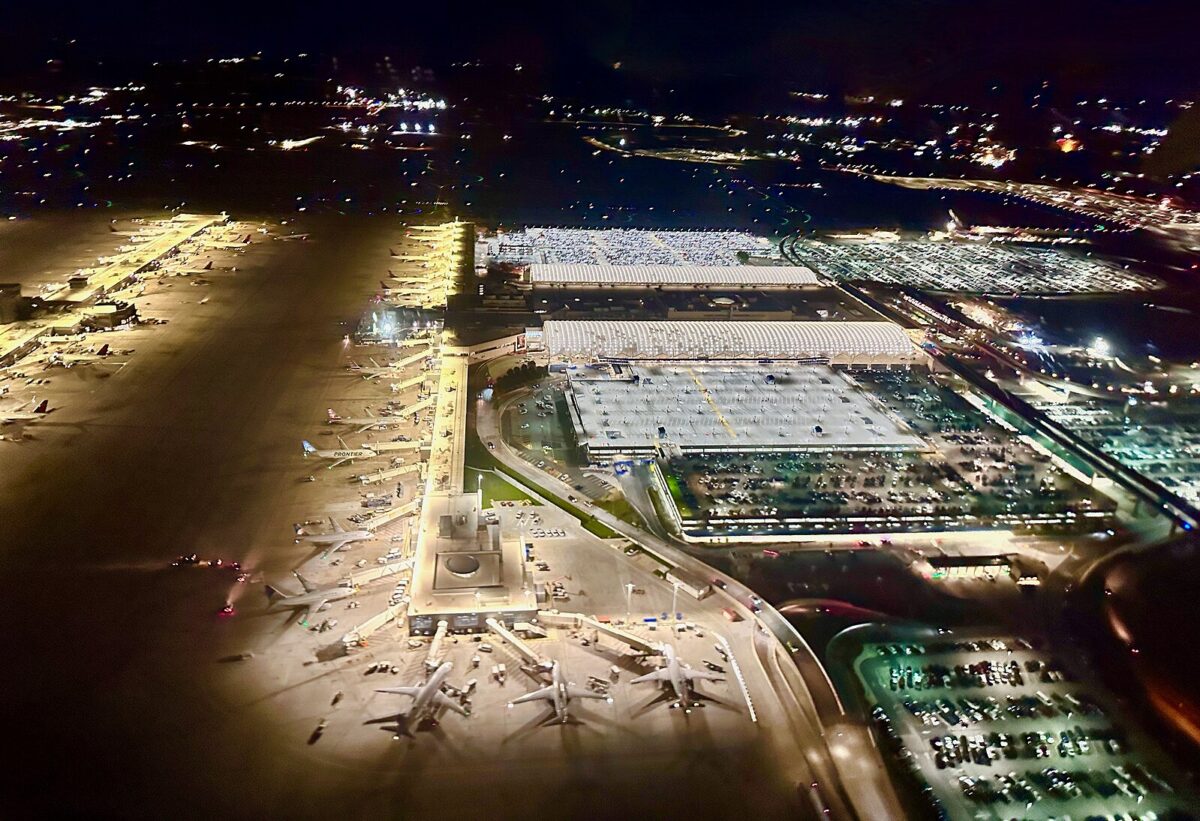Top 10 busiest airports in the world by flights

Aviation continues to grow, and in 2024, total airline capacity exceeded 2019 levels for the first time since the pandemic. As more passengers take to the skies, the world’s busiest airports are growing, too.
Aviation data experts OAG have released their ranking of the busiest airports in the world for 2024. Unsurprisingly, Atlanta Hartsfield-Jackson is on top again, as it was last year and in 2019. But there are some surprises in the list too, with a brand new airport in the top 10 as Shanghai Pudong continues its recovery.
Note: The data is based on the number of available seats departing the airport (one way) in 2024, but does not indicate whether all those seats were full. According to IATA, the average load factor globally in 2024 was 83.5%, so we can assume at least four-fifths of the seats were full.
All but two of the airports have increased their capacity compared to pre-pandemic levels, and one has grown by 24% since 2019. Stay with us as we take a look at the world’s busiest airports in more detail.
1. Hartsfield–Jackson Atlanta International Airport
Seats in 2024: 62,743,665
Atlanta Airport key statisticsOpened1926IATA codeATLHubbed airlinesDelta Air LinesRunways5Terminals2Annual passengers108 million (2024)Harrison Keely / WikimediaHome to Delta Air Lines, Atlanta serves more than 150 domestic and 70 international destinations, connecting the US to over 40 countries. Its terminal complex stretches over 6.8 million square feet and houses a total of 192 gates.
Atlanta has been the world’s busiest airport in terms of passenger traffic since 1998, with the exception of the pandemic year 2020. It increased its seat capacity by a modest 2%, although it remains just shy of its 2019 peak by 1%.
As well as being the busiest airport by both scheduled seats and passenger traffic, Atlanta links three of the top 10 busiest domestic routes in the US. That includes the busiest route overall – Atlanta to Orlando (MCO), with almost 3.5 million seats offered – and the eighth and ninth busiest, Atlanta to Fort Lauderdale (FLL) and New York (LGA).
2. Dubai International
Seats in 2024: 60,236,220
Dubai Airport key statisticsOpened1960IATA codeDXBHubbed airlinesEmirates, flydubaiRunways2Terminals3Annual passengers92 million (2024)Konstantin von Wedelstaedt / Wikimedia
With just two million fewer seats for sale, Dubai remains in second place on the busiest airports list. It was only fourth in 2019 but has continued to grow through the pandemic years, and is now operating 12% more flights than it did then.
In the last year alone, Dubai has grown its seat capacity by 7%, most of them international. This was reflected in the airport being ranked the busiest international airport of the year by OAG (Atlanta didn’t even make the top 10 on that list).
We could see a change at the top in 2025, as during the first quarter, Dubai outpaced Atlanta with 15.1 million departing seats. Whether it holds onto that lead through the rest of the year remains to be seen.
RELATED
Dubai Airport remains on track to handle over 90 million passengers in 2024
3. Tokyo Haneda
Seats in 2024: 55,204,580
Tokyo Haneda Airport key statisticsOpened1IATA codeHNDHubbed airlinesANA, Japan AirlinesRunways4Terminals3Annual passengers79 million (2023)
Tokyo Haneda AirportAs the primary domestic base for Japan’s two largest airlines, Haneda processes huge numbers of passengers each year, the majority for domestic flights. Its busiest route is to Sapporo, which saw more than nine million passengers last year, closely followed by Fukuoka with 8.6 million passengers.
The airport has seen moderate growth of 5% year on year and is up 1% over the number of seats it had pre-pandemic. As well as being an important hub for Japanese airlines, Haneda is served internationally by dozens of foreign airlines, including British Airways, American Airlines, Emirate, and Qantas.
Haneda’s 2024 was marred by a tragic runway collision in January, destroying a Japan Airlines Airbus A350, the first hull loss for the type, and claiming the lives of several coastguard workers. The airport has reportedly upgraded safety measures following the accident.
RELATED
First Japan Airlines A350-1000 enters service on Tokyo-Haneda to JFK route
4. London Heathrow
Seats in 2024: 51,553,190
London Heathrow Airport key statisticsOpened1946IATA codeLHRHubbed airlinesBritish Airways, Virgin AtlanticRunways2Terminals4Annual passengers84 million (2024)Heathrow AirportLondon Heathrow had its busiest ever year in 2024, with December breaking all records for passenger traffic. Over the year, the airport handled almost 84 million passengers, 6% more than in 2023. In terms of seats, Heathrow has added 4% in the last year, and 3% since 2019, when it was the seventh busiest airport.
Home to the 10th busiest route in the world – to New York JFK – Heathrow has seen extensive growth from its home carriers. In 2024, British Airways added flights to new destinations in Italy, Southeast Asia, Jeddah, and more. For 2025, Virgin Atlantic is launching flights to Riyadh and resuming Toronto and Accra.
With a new government in place, the UK has finally green-lit a third runway for Heathrow, although it’s not planned to be open before 2035. Nevertheless, the airport has big plans for the coming years, announcing a $3 billion investment between 2025 and 2026 to improve and update its terminals.
5. Dallas/Fort Worth
Seats in 2024: 51,516,707
Dallas/Fort Worth Airport key statisticsOpened1974IATA codeDFWHubbed airlinesAmerican AirlinesRunways7Terminals5Annual passengers82 million (2023)Dallas Fort Worth AirportHome to the American Airlines headquarters and its primary hub, Dallas/Fort Worth has grown substantially in the past few years. Since 2019, capacity at the airport has increased 18%, and 7% in the last year alone.
While many other airlines have added service to DFW, such as Fiji Airways with its new service from Nadi, a good deal of its growth has stemmed from American Airlines. It continues to expand, launching flights to Tokyo in June 2024, and placing a huge order for new aircraft in March to support future growth.
For Dallas/Fort Worth Airport, this year looks to bring more flights and new airlines. In 2025, Cathay Pacific will begin a connection from Hong Kong in April, while Taiwanese carrier EVA Air will launch nonstop flights to Dallas from its home in Taipei towards the end of the year. Also recently announced is a new route from Bogota with Avianca – details below.
RELATED
Avianca launches new direct route between Dallas and Bogotá starting May 2025
6. Denver International
Seats in 2024: 49,218,244
Denver Airport key statisticsOpened1995IATA codeDENHubbed airlinesUnited AirlinesRunways6Terminals1Annual passengers82 million (2024)Denver International AirportIf you thought the growth at Dallas was impressive, Denver is in a whole other league. According to OAG data, it has grown an amazing 24% in terms of capacity since 2019. In the past year, it has grown 5%, solidifying its place as the sixth busiest airport in the world.
The airport has seen some new additions in 2024, notably Turkish Airlines launching a nonstop to Istanbul. This route, at over 5,300 nautical miles, has dethroned United’s Tokyo Narita flight as the longest service out of Denver. Like Atlanta, Denver Airport is home to some of the busiest routes in the US, including fourth busiest to Phoenix and 10th busiest to Las Vegas.
Denver has room to grow further. It’s the biggest airport in the US by some margin in terms of landmass, and the third largest airport in the world. Coming in 2025, United is adding several new connections across North America, and launching an exciting new route to Rome. Equally excitingly, Lufthansa will upgrade its Munich service to an A380 from the end of April.
RELATED
Denver Airport conspiracy theories: debunking or unraveling the mystery?
7. Guangzhou Baiyun
Seats in 2024: 48,852,986
Guangzhou Baiyun Airport key statisticsOpened2004IATA codeCANHubbed airlinesChina Southern AirlinesRunways3Terminals2Annual passengers76 million (2024)byeangel / WikimediaWith Asia shut down for much longer during the pandemic than other parts of the world, some airports have struggled to regain their pre-crisis traffic. This year, though, several major airports, particularly in China, have come roaring back to life, many exceeding their pre-pandemic capacity. Guangzhou Baiyun (CAN) is one such airport.
It’s grown substantially both through and after the pandemic, maintaining an impressive operation even when the international flights disappeared. In fact, during the worst of the crisis, CAN outpaced struggling Atlanta to become the busiest airport in the world in 2020.
In the last year alone, the airport has increased the number of seats on sale by 12%, enabling it to scoot up the table from 10th busiest in 2023 to seventh busiest this year. Seventy-six million passengers passed through the airport in 2024, a record for Guangzhou Baiyun and an increase of 20% year on year.
China Southern has driven much of the growth at Guangzhou, and 2024 saw it establishing many new routes. Among those was a thrice-weekly connection to London Gatwick, new direct flights to Doha, and a resumption of service to Adelaide. Coming in 2025, Air Astana will begin flights between CAN and Almaty, while Air Serbia plans to continue its route connecting Guangzhou with Belgrade.
8. Istanbul Airport
Seats in 2024: 48,517,967
Istanbul Airport key statisticsOpened2018IATA codeISTHubbed airlinesTurkish AirlinesRunways5Terminals1Annual passengers80 million (2024)Alonso-brosmann / GoodFonOnly open since 2018, and only properly for commercial flights since 2019, Istanbul Airport has seen solid growth over the past few years. Since 2019, it has added 15% more seats for sale, with 5% added just last year. But it slipped down the busiest airport rankings, pushed down from seventh by Guangzhou by a couple of hundred seats, and clinging on to eighth position, just 14,000 seats ahead of Shanghai.
Turkish Airlines is already the airline that flies to more destinations than any other, reaching 269 cities in 131 countries. Yet, still it adds new routes, most notably launching flights to Australia in 2024. It also added Santiago de Chile, restored flights to Afghanistan after three years, and resumed service to Damascus (DAM) and Benghazi (BEN).
An interesting addition in 2024 was Air Samarkand, the Uzbekistan startup, which launched flights to Istanbul in March. Coming in 2025 is a new SKY Express service linking Athens and Icelandair from Reykjavik in September. Turkish continues its expansion too, with Auckland (AKL) and Minneapolis (MSP) on its radar for 2025.
RELATED
iGA Istanbul Airport: Taking airport technology innovation to the next level
9. Shanghai Pudong International
Seats in 2024: 48,503,741
Shanghai Pudong Airport key statisticsOpened1999IATA codePVGHubbed airlinesChina Eastern, Air China, Shanghai AirlinesRunways5Terminals2Annual passengers77 million (2024)Nkon21 / WikimediaShanghai Pudong has come roaring back up the busiest airport chart with more than 48.5 million scheduled seats in 2024. That’s a staggering growth of 29% year on year, making it the most rapidly growing airport in the top 10. It now sits just above pre-pandemic capacity (+3%) and is showing no signs of slowing down.
With Russian airspace closures, several European airlines have pulled out of flights to China, but Pudong has grown anyway, thanks to the efforts of its home airlines. Both Hainan Airlines and Juneyao resumed flying to Brussels (BRU) in 2024, while Juneyao also added Manchester (MAN) and Sydney (SYD).
The big Chinese carriers added many destinations, including Venice, Munich, Marseilles and more, while Air Serbia bucked the trend and began flying to PVG in January 2025.
Pudong is the 10th largest airport in the world by landmass, spanning 16 square miles. It’s planning to make use of some of that space with a new third terminal and associated developments. When it’s completed in 2028, the airport should be capable of handling 130 million passengers a year and more than 800,000 flights.
10. Chicago O’Hare International
Seats in 2024: 46,992,360
Chicago O’Hare Airport key statisticsOpened1955IATA codeORDHubbed airlinesUnited Airlines, American AirlinesRunways8Terminals4Annual passengers74 million (2023)Nicola Delfino / WikimediaOver at Chicago O’Hare, the story is not so much one of success but more a case of holding grimly on to 10th position on the list. ORD added 8% more seat capacity in 2024, which is an impressive level of growth, but despite this, it remains 7% under its capacity for 2019, when it was the world’s sixth busiest airport. Nevertheless, its year-on-year growth has seen it claw its way back up the table from 15th position in 2023 to 10th this year.
United provides the lion’s share of capacity from Chicago, operating 52% of the flights. It had a record winter for flying, extending some European routes out of Chicago later into the season and adding several new Latin American destinations. Although it had more than half the flights, United says it only has 48% of the gates, and is hoping for more gates in 2025 to support further expansion.
The airport had some knockbacks in 2024, most notably Air New Zealand suspending its Auckland service due to engine issues. But it had some new arrivals too, with Avianca inaugurating a Bogota route in October, and ITA launching Rome flights in April. American plans to begin Madrid flights from ORD at the end of March 2025.
While ORD is growing its international connections, it remains an important domestic airport too. The route from Chicago O’Hare to New York La Guardia (LGA) is the seventh busiest domestic route in the US with more than 1.15 million passengers a year, while both Los Angeles and Denver see more than a million passengers annually. It was named the most well-connected airport in the US by OAG in 2024.
RELATED
Top 10: The busiest domestic flight routes in the USA in 2024
The post Top 10 busiest airports in the world by flights appeared first on AeroTime.
Aviation continues to grow, and in 2024, total airline capacity exceeded 2019 levels for the first time since…
The post Top 10 busiest airports in the world by flights appeared first on AeroTime.




